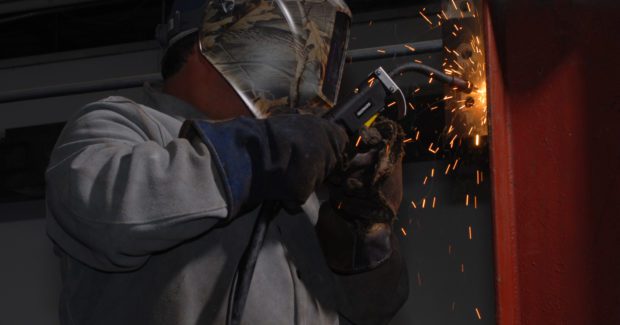How to Increase Productivity with Self-Shielded Flux-Cored Wire
What if you could obtain high quality welds outdoors without the productivity slowdowns associated with changing stick electrodes? Self-shielded flux-cored wires allow welders to continue working without interruption. These wires have changed and improved from what was available several years ago, but you must understand how to select the best wire for the job.
Posted: August 16, 2018
Stick welding is often an obvious choice for welding in outdoor applications due to its portability – there is no shielding gas or wire feeders required. When using stick electrodes, however, welding operators need to stop frequently to change them out. This activity creates unproductive downtime, as well as decreased deposition efficiency due to stub loss that hurts your bottom line. But what if you could obtain high quality welds outdoors without the productivity slowdowns associated with changing stick electrodes? Self-shielded flux-cored (FCAW-S) wires can help, allowing welders to continue working without interruption. Today’s FCAW-S wires have changed from what was available several years ago. Advancements in formulations have improved operator appeal, as well as mechanical properties, with the wires delivering smoother, cleaner welds with less spatter and faster-freezing weld pools. If you tried FCAW-S wire in the past and decided it wasn’t a good fit for your application, it may be worth re-evaluating.
It’s important to note that a variety of FCAW-S wires are available, each with different American Welding Society (AWS; Miami, FL) classifications to meet the needs of fabrication, construction, shipbuilding, offshore and many other applications. It’s equally important to note that mechanical and chemical properties of FCAW-S wire classifications vary, as do weldability and general capabilities. In short, you need to understand how to select the best FCAW-S wire for the job. Once you’ve selected the right wire, it’s crucial to follow that wire’s recommended stickout/electrode extension and weld parameters. Many wires call for welding in DC electrode negative (DCEN) polarity, but some require DC electrode positive (DCEP) polarity. For the best results, follow the recommendations of the wire manufacturer.
SELF-SHIELDED FLUX CORE CHOICES
The more-common carbon steel self-shielded products are listed below, along with their typical uses, properties and advantages. With this information, you can get a good start on selecting the right wire for your applications:
- T-4. Used for high deposition welding, these wires offer good resistance to cracking. They’re used in applications like machine fabrication, industrial welding and heavy equipment repair. Due to their high deposition rates, these wires should only be used in flat and horizontal welding; they require using DCEP polarity. For the AWS A5.20 (Specification for Carbon Steel Electrodes for Flux-Cored Arc Welding), there are no impact toughness requirements for the T-4 classification, which may limit its use in some applications.
- T-6. These wires also provide good depositions rates, as well as some low-temperature impact toughness (20 ft-lb at -20 deg F), which makes them a good choice for certain structural steel applications. Many T-6 wires also conform to the D1.8 Structural Welding Code – Seismic Supplements. T-6 wires can be used for single or multi-pass applications and have excellent slag removal. Due to their high deposition rates, these wires should only be used in flat and horizontal welding; they require using DCEP polarity.
- T-7. Another high deposition wire, T-7 is also designed to run only in the flat and horizontal position. Their good arc performance makes this wire a smart choice for applications like shipbuilding and structural steel fabrication. T-7 wires can be used for single or multi-pass applications; their low sulfur content adds resistance to hot cracking. These wires are welded using DCEN polarity. As with T-4 wires, T-7 wires under AWS 5.20 classification have no impact toughness requirements, which may limit their use in some applications.
- T-8. These versatile wires can be welded in all positions, for single or multi-pass welding and are available in mild steel, as well as low-alloy formulations. They have good low-temperature impact toughness, with a minimum of 20 ft-lb at -20 deg F (carbon steel), but many T-8 wires are designated with the J classification. For AWS A5.20 wires, the J designation indicates a minimum impact toughness requirement of 20 ft-lb at -40 deg F. For low-alloy products with AWS A5.29 (Specification for Low-Alloy Steel Electrodes for Flux-Cored Arc Welding), classifications, the J designator means the toughness requirement is 20 ft-lb at a test temperature of 20 de F lower than the temperature shown for a classification without the “J” designator.
In mild steel products, some of the T-8 wires also conform to the D1.8 Structural Welding Code – Seismic Supplements. Due to the T-8 versatility, they can fit a wide range of applications including structural steel, fabrication, shipbuilding, bridge construction, offshore rig construction and various grades of onshore transmission pipelines. Although all T-8 wires are run in DCEN polarity, due to the wide range of options, it’s important to carefully review the product type and ensure it’s the right fit for the application.
- T-11. This wire type is an excellent choice for general fabrication, pre-fab construction, machine parts, repair welding, home or farm project welding or galvanized welding, but it’s not recommended to weld materials thicker than 3/4 in. T-11 wires can be used in single or multiple passes and come in a large range of diameters, typically from 0.030 in up to 5/64 in. All T-11 wires should be run using DCEN polarity. Again, under AWS A5.20, because there are no impact toughness requirements for the T-11 classification, its use may be limited.
As with the selection of any filler metal, when determining which FCAW-S wire is best for your application, consult with a trusted welding distributor or filler metal manufacturer when in doubt. Having the right wire can help improve productivity, especially compared to stick electrodes, and provide the quality needed for the job.

















